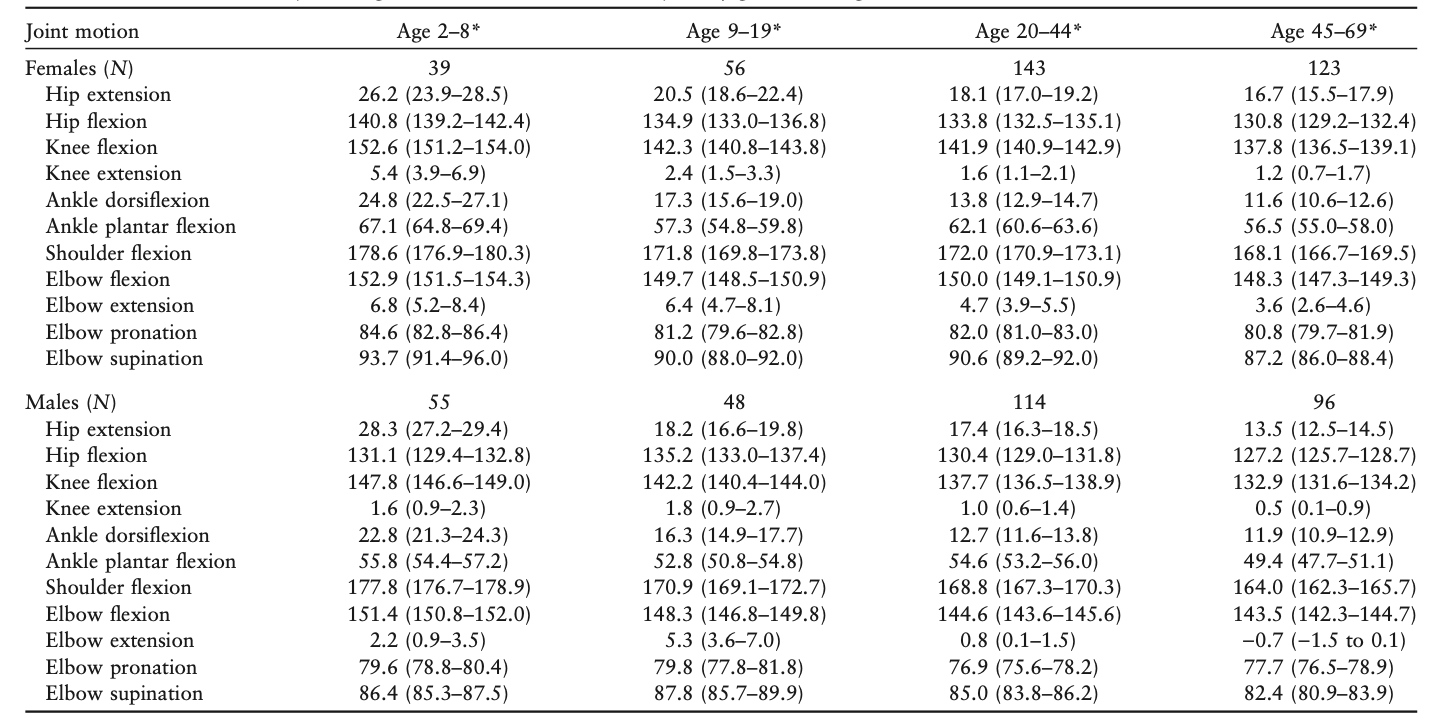[1]
Gates DH, Walters LS, Cowley J, Wilken JM, Resnik L. Range of Motion Requirements for Upper-Limb Activities of Daily Living. The American journal of occupational therapy : official publication of the American Occupational Therapy Association. 2016 Jan-Feb:70(1):7001350010p1-7001350010p10. doi: 10.5014/ajot.2016.015487. Epub
[PubMed PMID: 26709433]
[2]
Keogh JWL, Cox A, Anderson S, Liew B, Olsen A, Schram B, Furness J. Reliability and validity of clinically accessible smartphone applications to measure joint range of motion: A systematic review. PloS one. 2019:14(5):e0215806. doi: 10.1371/journal.pone.0215806. Epub 2019 May 8
[PubMed PMID: 31067247]
Level 1 (high-level) evidence
[3]
Hancock GE, Hepworth T, Wembridge K. Accuracy and reliability of knee goniometry methods. Journal of experimental orthopaedics. 2018 Oct 19:5(1):46. doi: 10.1186/s40634-018-0161-5. Epub 2018 Oct 19
[PubMed PMID: 30341552]
[4]
Nizamis K, Rijken NHM, Mendes A, Janssen MMHP, Bergsma A, Koopman BFJM. A Novel Setup and Protocol to Measure the Range of Motion of the Wrist and the Hand. Sensors (Basel, Switzerland). 2018 Sep 25:18(10):. doi: 10.3390/s18103230. Epub 2018 Sep 25
[PubMed PMID: 30257521]
[5]
Bronner S, Agraharasamakulam S, Ojofeitimi S. Reliability and validity of electrogoniometry measurement of lower extremity movement. Journal of medical engineering & technology. 2010 Apr:34(3):232-42. doi: 10.3109/03091900903580512. Epub
[PubMed PMID: 20180734]
[6]
Ockendon M, Gilbert RE. Validation of a novel smartphone accelerometer-based knee goniometer. The journal of knee surgery. 2012 Sep:25(4):341-5
[PubMed PMID: 23150162]
Level 1 (high-level) evidence
[7]
Jones A, Sealey R, Crowe M, Gordon S. Concurrent validity and reliability of the Simple Goniometer iPhone app compared with the Universal Goniometer. Physiotherapy theory and practice. 2014 Oct:30(7):512-6. doi: 10.3109/09593985.2014.900835. Epub 2014 Mar 25
[PubMed PMID: 24666408]
[8]
Ferriero G, Vercelli S, Sartorio F, Muñoz Lasa S, Ilieva E, Brigatti E, Ruella C, Foti C. Reliability of a smartphone-based goniometer for knee joint goniometry. International journal of rehabilitation research. Internationale Zeitschrift fur Rehabilitationsforschung. Revue internationale de recherches de readaptation. 2013 Jun:36(2):146-51. doi: 10.1097/MRR.0b013e32835b8269. Epub
[PubMed PMID: 23196790]
[9]
Ferriero G, Sartorio F, Foti C, Primavera D, Brigatti E, Vercelli S. Reliability of a new application for smartphones (DrGoniometer) for elbow angle measurement. PM & R : the journal of injury, function, and rehabilitation. 2011 Dec:3(12):1153-4. doi: 10.1016/j.pmrj.2011.05.014. Epub
[PubMed PMID: 22192326]
[10]
Carley P, Burkhart KL, Sheridan C. Virtual Reality vs Goniometry: Intraclass Correlation Coefficient to Determine Inter-Rater Reliability for Measuring Shoulder Range of Motion. Journal of allied health. 2021 Summer:50(2):161-165
[PubMed PMID: 34061937]
[11]
Soucie JM, Wang C, Forsyth A, Funk S, Denny M, Roach KE, Boone D, Hemophilia Treatment Center Network. Range of motion measurements: reference values and a database for comparison studies. Haemophilia : the official journal of the World Federation of Hemophilia. 2011 May:17(3):500-7. doi: 10.1111/j.1365-2516.2010.02399.x. Epub 2010 Nov 11
[PubMed PMID: 21070485]
[12]
Milanese S, Gordon S, Buettner P, Flavell C, Ruston S, Coe D, O'Sullivan W, McCormack S. Reliability and concurrent validity of knee angle measurement: smart phone app versus universal goniometer used by experienced and novice clinicians. Manual therapy. 2014 Dec:19(6):569-74. doi: 10.1016/j.math.2014.05.009. Epub 2014 Jun 4
[PubMed PMID: 24942491]
[13]
Mourcou Q, Fleury A, Diot B, Franco C, Vuillerme N. Mobile Phone-Based Joint Angle Measurement for Functional Assessment and Rehabilitation of Proprioception. BioMed research international. 2015:2015():328142. doi: 10.1155/2015/328142. Epub 2015 Oct 25
[PubMed PMID: 26583101]
[14]
Gajdosik RL, Bohannon RW. Clinical measurement of range of motion. Review of goniometry emphasizing reliability and validity. Physical therapy. 1987 Dec:67(12):1867-72
[PubMed PMID: 3685114]

